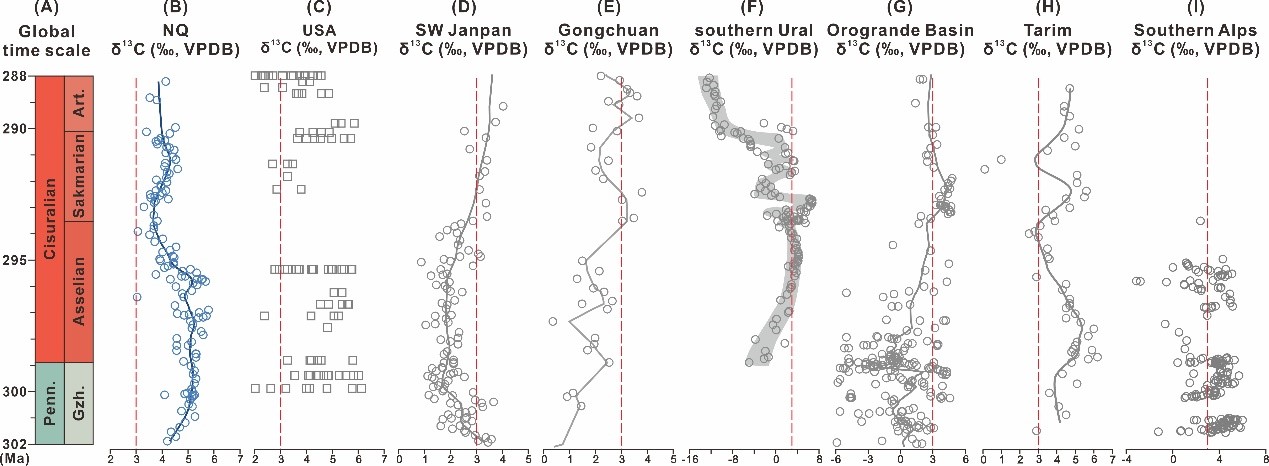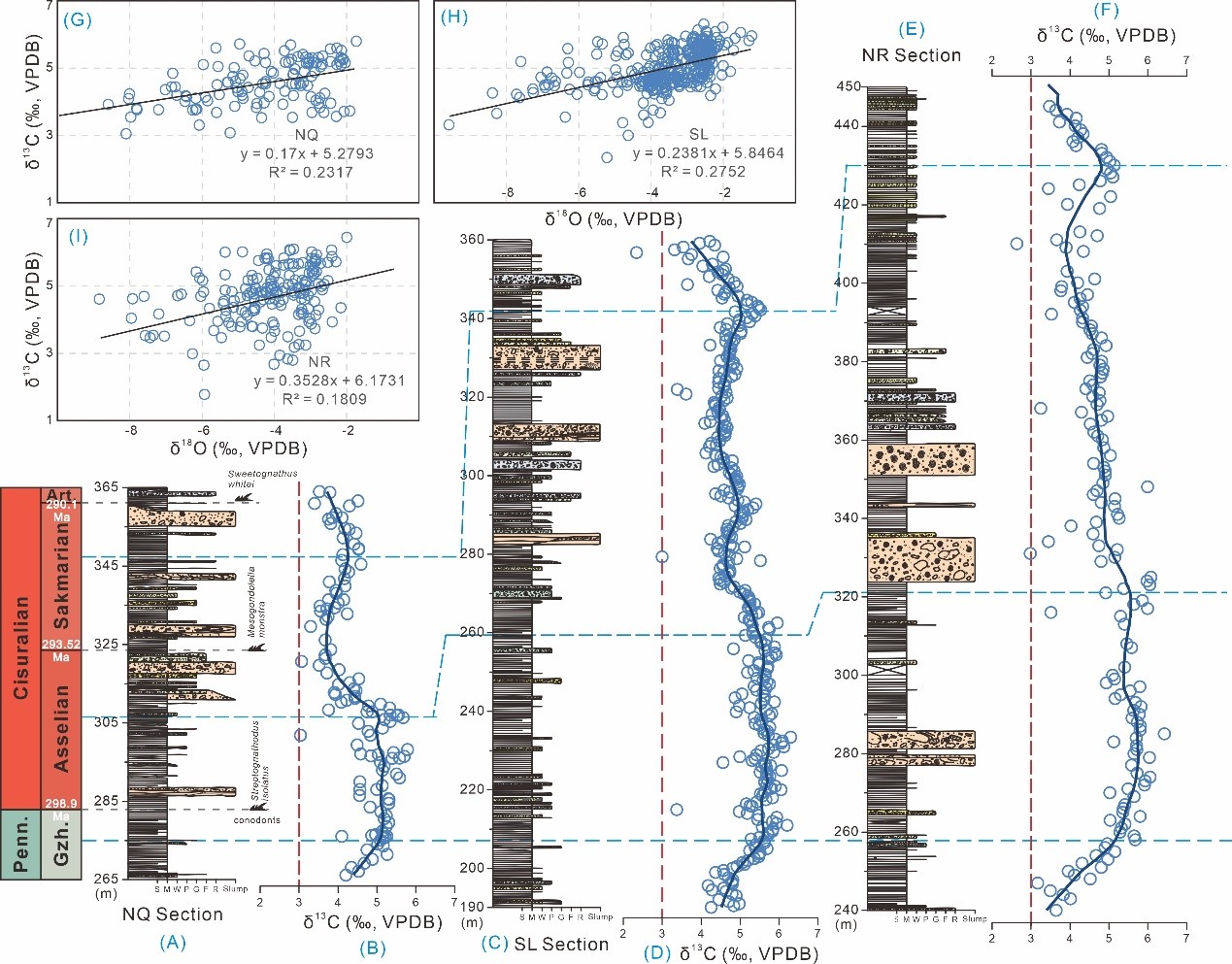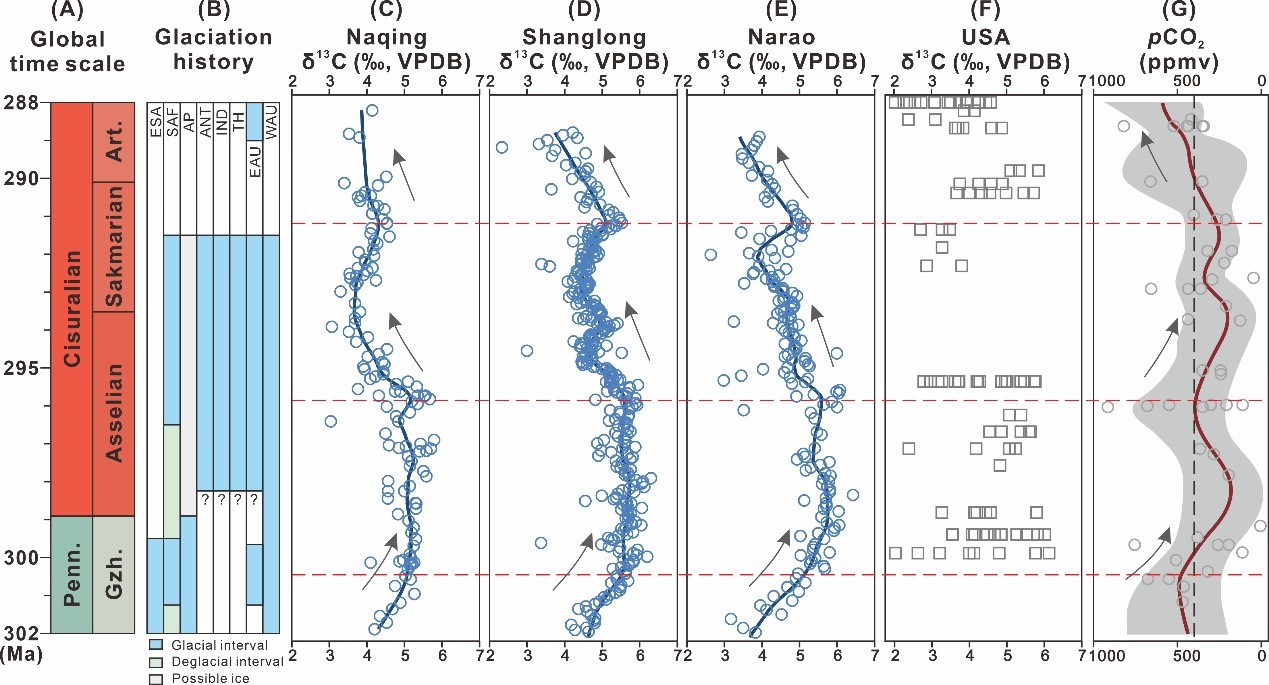Reliable carbonate carbon isotopes (δ13Ccarb) are valuable information that can reflect variations in global carbon cycling, and thus the paleoclimate and paleoceanographic conditions. However, expansion of the Gondwanan ice sheets, combined with tectonic uplift (e.g., Hercynian orogenesis), significant sea-level changes with multiple periods of significant depositional hiatus in low-latitude areas occurred during the late Pennsylvanian to early Cisuralian. Frequent subaerial exposures and stratigraphic discontinuities could have potentially altered the primary δ13Ccarb signals, which collectively hampered a valid global correlation at this time (Fig. 1). Indeed, a global δ13Ccarb record is hardly established for chemostratigraphic correlation and global carbon cycle modeling.
The South China Block was located in the low-latitude region at the confluence of the eastern Paleo-Tethys Ocean and western Panthalassic Ocean during the Pennsylvanian and Cisuralian. Various sedimentary facies ranging from carbonate platforms to regional slopes and basins developed in South China during the Pennsylvanian to Cisuralian, which were well connected to open ocean waters, potentially recording a global seawater geochemical signal.
Recently, a detailed study on sedimentary facies and high-resolution carbonate δ13C is conducted on the Pennsylvanian and Cisuralian carbonate slope successions from the South China Block by the Ph.D. student YANG Wenli, Prof. CHEN Jitao, and other colleagues from Nanjing Institute of Geology and Palaeontology, Chinese Academy of Sciences (NIGPAS). The study is published in the international journal Global and Planetary Change.
Detailed sedimentary facies analysis and high-resolution δ13Ccarb time series (Fig. 2) during the late Pennsylvanian to early Cisuralian suggest that the δ13Ccarb recorded in slope carbonates of the Luodian Basin may represent a reliable proxy for global carbon cycling. Across the Carboniferous-Permian transition, the well-coupled δ13Ccarb, atmospheric pCO2, and the inferred glacial records (Fig. 3), suggest a potential linkage between increased rate of organic carbon burial and the apex of the LPIA. The decoupling between the δ13Ccarb and atmospheric pCO2 during the middle Asselian to mid-late Sakmarian suggests that enhanced silicate weathering might have played a dominant role in drawdown of atmospheric pCO2 and sustained glaciation. The rapid negative excursion in δ13Ccarb coincide with the rapid rise of atmospheric pCO2 and the substantial decrease in inferred glacial records, suggesting that the prolonged greenhouse gas accumulation potentially drove the transition from icehouse to greenhouse climate states.
The research is supported by the Strategic Priority Research Program of the Chinese Academy of Sciences and the National Natural Science Foundation of China. This is also a contribution to IGCP project 700 (Carbonate Build-Ups in South East Asia).
Reference: Yang, W.L., Chen, J.T.*, Gao, B., Zhong, Y.T., Huang, X., Wang, Y.*, Qi, Y.P., Shen, K.-S., Mii, H.-S., Wang, X.-d., and Shen, S.-z., 2023. Sedimentary facies and carbon isotopes of the Upper Carboniferous to Lower Permian in South China: Implications for icehouse to greenhouse transition. Global and Planetary Change. 223, 104051. https://doi.org/10.1016/j.gloplacha.2023.104051.

Figure 1. Comparison of global trends of carbonate δ13C during the late Pennsylvanian to the Cisuralian.

Figure 2. Sedimentary loggings and carbonate δ13C of the study sections.

Figure 3. Correlations of δ13C from the study sections and global glacial events and atmospheric pCO2 during the late Pennsylvanian and Cisuralian.
Contact:
LIU Yun, Propagandist
Email: yunliu@nigpas.ac.cn
Nanjing Institute of Geology and Palaeontology, Chinese Academy of Sciences
Nanjing, Jiangsu 210008, China
Download:
